| Sunday, April 4, 2004 |  |
|
|
|
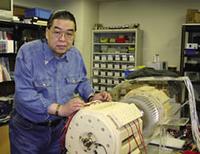 From japan.com, a story about inventor Kohei Minato and his Japan Magnetic Fan Company. He has apparently come up with a magnetic motor that consumes stunningly little electricity. OK, let's cut to the chase: it uses so little electricity that you can connect up a generator to it and get out more electricity than you put in. I.e. it is an over-unity device. From japan.com, a story about inventor Kohei Minato and his Japan Magnetic Fan Company. He has apparently come up with a magnetic motor that consumes stunningly little electricity. OK, let's cut to the chase: it uses so little electricity that you can connect up a generator to it and get out more electricity than you put in. I.e. it is an over-unity device.
What typically happens with over-unity devices is either that the inventor is found to be a con artist, who had hidden wires built into the table or something, and who just wanted to scam investors out of money. Or the patent gets bought up by General Motors, and nobody ever hears about it again. Or the inventor suddenly meets his untimely death in a freak boating accident.
The general consensus among people who're interested in that kind of thing, and actually serious about it, is that the only ways of ever getting an invention like that to market would either be to release workable blueprints all over the Internet, or it would be to camouflage it as an ordinary product that simply is unusually efficient. Minato is following he latter approach. Apparently he has sold 40,000 units to be used to drive cooling fans in convenience stores in Japan. So, just energy-efficient motors. Nobody can have a problem with that, right? And if he gets away with that, he can do something a little more bold with it next.
You can find some technical comments on how Minato's device might work from Tom Bearden, one of the gurus of over-unity theory, here, down in the middle of the page. But, warning, this is all impossible according to your highschool physics. If this kind of thing works, the energy will be coming from tapping ubiquitous fields that mainstream science simply doesn't believe in.
[ Technology | 2004-04-04 12:07 | | PermaLink ] More >
|
|
| Saturday, April 3, 2004 |  |
|
|
|
 Ton Zylstra recently commented on how the accepted norms around picture taking have changed. At least in a crowd of techies where everybody has at least one digital camera with them at all times. People no longer seem to mind constant picture taking. They mostly don't stop what they're doing and start posing. Which makes it easier to take good pictures of what is really going on. Ton Zylstra recently commented on how the accepted norms around picture taking have changed. At least in a crowd of techies where everybody has at least one digital camera with them at all times. People no longer seem to mind constant picture taking. They mostly don't stop what they're doing and start posing. Which makes it easier to take good pictures of what is really going on.
Personally I always have a problem when taking pictures. I'm in the middle of some experience, and I'd like to capture it. But the moment I pull out my camera, it is already a different experience and the presense of the camera changes it a bit. Just as much because of my own hangups as based on people's reactions. As, really, a lot of people no longer care. But I somehow never have a photographer identity. Somebody who is a "real" photographer doesn't hesitate in walking up front and sticking a camera in somebody's face, and hanging around a bit to get a good shot. But that is often because they don't consider themselves part of the action, but rather an independent observer who can float around as they wish, and who consider themselves having the right to photograph whatever is there. I'm usually a lot more self-conscious and try not to intrude. And I personally have a hard time being invisible. So often I don't get the pictures that were there to be gotten.
What would appeal to me would be an always-on camera on my body that simply recorded everything I was seeing, and then I could go and pick out the good parts later. So I could then concentrate on my experiences, and I could reference the recordings based on my own peak moments, and go back and find the exact picture that best shows it.
There are all kinds of issues in that, of course. Such as privacy. Is it ok to record people covertly? What if there was a light that showed that recording was taking place? See, it doesn't have to be a secret, but I'd like to get around the akwardness of the picture taking moment. If everything is recorded, both I and others will get used to it and not change our behavior.
There's an article on Hewlett Packard's site about always-on cameras, and the various issues surrounding the idea. The privacy issues again. But they're also trying to address the technical issues of how to find the interesting moments. If you record what you did for 8 hours, chances are that most of it was really boring and not worth keeping. So, can some automated software tool help you pick out the good parts? Personally I don't care about that overly much. I'd be happy with the ability to scan through the recordings really quickly, and to reference them by time. I pretty much know what times were worthwhile, so I just need to be able to find them again, which I can do visually, if I can scan through the day in a couple of minutes.
HP doesn't seem to be planning a product any time soon. But somebody will do it. Within less than five years, I'm sure. A tiny multi-gigabyte harddisk can quite well record video of your whole day. A high quality camera can quite well fit unobtrusively into a pair of glasses. The technical problems aren't hard. And if first a bunch of techheads start having these, and others think it is cool, there's no turning back.
Despite that many people will have hesitations about allowing such things, I think there are many advantages and many side benefits. See Britt Blaser's idea of the Personal Flight Recorder. If lots of people have always-on cameras, continuously recording, crime as we know it will change. It is much harder to hide shadey dealings, much harder to deny what really went on. The key point is that these things will be in the hands of individuals, not some authoritarian government. Of course I'm trying to avoid thinking about scenarios where the FBI forces some backdoor to be built-in, so they can tap anybody's feed as they please. The answer is to put the technology into common use before they get around to demanding such things.
.. Whaddya know, no sooner have I written the above before a couple of synchronistic and very related items show up. So, for more exciting stuff on that, see Britt's recent post on "sousveillance", and Joi Ito's mention of an International Workshop on Inverse Surveillance in Toronto April 12th. Exactly on these kinds of subjects. See this topic list:* Camera phones and pocket organizers with sensors;
* Weblogs ('blogs), Moblogs, Cyborglogs ('glogs);
* Wearable camera phones and personal imaging systems;
* Electric eyeglasses and other computational seeing and memory aids;
* Recording experiences in which you are a participant;
* Portable personal imaging and multimedia;
* Wearable technologies and systems;
* Ethical, legal, and policy issues;
* Privacy and related technosocial issues;
* Democracy and emergent democracy (protesters organizing with SMS camphones);
* Safety and security;
* Technologies of lifelong video capture;
* Personal safety devices and wearable "black box" recorders;
* Research issues in "people looking at people";
* Person-to-person sharing of personal experiences;
* End of gender-specific space (e.g. blind man guided by wife: which restroom?);
* Subjectright: ownership of photograph by subject rather than photographer;
* Reverse copyright: protect information recipient, not just the transmitient;
* Interoperability and open standards;
* Algebraic Projective Geometry from a first-person perspective;
* Object Detection and Recognition from a first-person perspective;
* Computer Vision, egonomotion and way-finding technologies;
* Lifelong Image Capture: data organization; new cinematographic genres;
* New Devices and Technologies for ultra miniature portable cameras;
* Social Issues: fashion, design, acceptability and human factors;
* Electronic News-gathering and Journalism;
* Psychogeography, location-based wearable computing;
* Augmented/Mediated/Diminished Reality;
* Empowering children with inverse surveillance: Constructionist learning, creation of own family album, and prevention of both bullying by peers and abuse by teachers or other officials. And here, from Britt is a comparison of surveillance and "sousveillance". Splendid word.| Surveillance | Sousveillance |
|---|
| Sur-veiller is French for "to watch from above". | Sous-veiller is French for "to watch from below". | God's eye view from above.
(Authority watching from on-high.) | Human's eye view.
("Down-to-earth.") | | Cameras usually mounted on high poles, up on ceiling, etc. | Cameras down-to-earth (at ground level), e.g. at human eye-level. | | Architecture-centered (e.g. cameras usually mounted on or in structures). | Human-centered (e.g. cameras carried or worn by, or on, people). | | Recordings of an activity made by authorities, remote security staff, etc. | Recordings of an activity made by a participant in the activity. |
"Inverse surveillance is the imminent device-driven tsunami whereby we commoners take back our commons. We will be using our always-on videophones to capture the passing scene. The result will be that our blanket, overlapping and corroborating public record captured by our high-res private devices will overwhelm the spotty, lo-res record of incidents captured by so-called public surveillance devices."
Yeah, let's turn it all around. I love it. There's nowhere to hide from the people.
[ Technology | 2004-04-03 05:27 | | PermaLink ] More >
|
|
| Friday, March 26, 2004 |  |
|
|
|
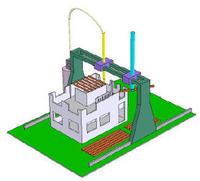 According to New Scientist, a Southern California engineer, Behrokh Khoshnevis, has been working on a robot that can "print" houses. There are devices that are quite a bit like inkjet printers, but which output 3D models in plastic by building them from the bottom up, layer by layer, by spraying out little globs of plastic. This would be the same kind of idea, but it would be a bigger machine, and it might use a kind of concrete. They haven't actually worked out the perfect material yet, and he's collaborating with a company in Germany to find it. However, ironically, it seems that adobe, a traditional mix of mud and straw, could be quite suitable for this process. Wouldn't that be something. According to New Scientist, a Southern California engineer, Behrokh Khoshnevis, has been working on a robot that can "print" houses. There are devices that are quite a bit like inkjet printers, but which output 3D models in plastic by building them from the bottom up, layer by layer, by spraying out little globs of plastic. This would be the same kind of idea, but it would be a bigger machine, and it might use a kind of concrete. They haven't actually worked out the perfect material yet, and he's collaborating with a company in Germany to find it. However, ironically, it seems that adobe, a traditional mix of mud and straw, could be quite suitable for this process. Wouldn't that be something.
The process is called "Contour Crafting". Other, more detailed, articles are here and here.
[ Technology | 2004-03-26 14:39 | | PermaLink ] More >
|
|
| Thursday, March 25, 2004 |  |
|
|
|
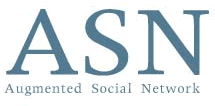 Seb Paquet talks about an interview with Ken Jordan, one of the authors of the Augmented Social Network whitepaper. ASN is probably the smartest vision that exists so far for how online social networks ought to work. Here in Ken Jordan's words: Seb Paquet talks about an interview with Ken Jordan, one of the authors of the Augmented Social Network whitepaper. ASN is probably the smartest vision that exists so far for how online social networks ought to work. Here in Ken Jordan's words:"The ASN is a blue sky vision for the future of online community. It stakes out some conceptual territory, presenting a civil society vision of how the Internet could evolve — particularly addressing the issues of Identity and Trust (two packed terms that have a pretty specific meaning in this context). It provides a clear alternative to the dangerous direction the Internet may well be heading in — a corporate/government panopticon. But it’s not enough to stand against digital disempowerment and control; we need to stand for something. The ASN shows that by coordinating the writing of standards and protocols between several different, previously separate technical areas (persistent identity, interoperability between community infrastructures, matching technologies, and brokering) you could add a layer of functionality to the Internet that would be greatly in the public interest." ASN grew out of the PlanetWork conferences in the Bay area, so a few words about its history probably helps. Here's part of the intro by Geert Lovink, the interviewer:Planetwork was founded in 1998 by Erik Davis, Jim Fournier, Elizabeth Thompson and David Ulansey. It is a network in which activists mingle with technologists. It’s aim has been to connect issues of global ecology and information technology. Politically speaking Planetwork is a civil society initiative that strategically positions itself as part of Silicon Valley, while at the same time celebrating the Seattle protests against corporate dominance. A typical post-dotcom phenomena, one could say. They are not so much driven by selfish libertarian greed, as once propagated by Wired. Rather, they are an incarnation of the hippie values and ideas that once circulated in the Well. I know, in California such distinctions may seem problematic, but it is nonetheless important to stress that there is still, or again, a progressive agenda within the IT-sector. Lots of good stuff in the interview. Ken Jordan also comments on the current social networking sites, like Friendster and Orkut, as falling far
short of what the ASN would do.. Here's a Seb Paquet's summary and comments:Jordan enumerates shortcomings of current social networking systems such as Friendster:
1. They are non-interoperable walled gardens.
2. Profile info is thin, not nuanced; it isn’t context sensitive (the boss and mother problem).
3. The profile information is static, not effected by your actions elsewhere.
4. You have limited control over your own profile information (“It calls for a new class of services: identity brokers”; you also want a “digital bill of rights” that enables you to exert control over access.)
5. The sites are exclusive, invitation-only clubs. [Note: I believe this is the exception rather than the norm].
I can’t help but notice how close weblogs come to fitting the bill - apart from restricting you to a single context and making it difficult to control acess, everything is in there. (See Dina Mehta and Lilia Efimova on blogs as SNSes.) Anyway, ASN is very important. I hope a structure comes together for how some software could actually be written for it.
Btw, next Planetwork conference is June 5th and 6th.
[ Technology | 2004-03-25 16:00 | 0 comments | PermaLink ]
|
|
| Saturday, January 17, 2004 |  |
|
|
|
 The Moller SkyCar seems to be making progress. If you don't know what it is, it is a project to make a flying car about the same size and price as a big Mercedes automobile. But which can fly 500km/h, by auto-pilot, and which can hover in the air and land just about anywhere. The Moller SkyCar seems to be making progress. If you don't know what it is, it is a project to make a flying car about the same size and price as a big Mercedes automobile. But which can fly 500km/h, by auto-pilot, and which can hover in the air and land just about anywhere.
Paul Moller's company has worked on it for years. It is a significant enginineering task. They've spent 100 million dollars on R&D, which is really very little in this context. Recently they've done successful hover tests, and expect to do full flight testing within 5 months.
Seems like it would at the earliest be available for real use in about 4 years. But you can reserve yours right now if you can afford it. Various things will need to happen before it can be in normal use, as it is intended to fly by computer control in designated highway corridors in the air. So that needs to be set aside, and the thing needs to be approved by the proper authorities.
And, yes, it guzzles gas. Per kilometer it won't be anything more than a regular car. But you're of course more likely to go shopping 100s of km away if you have one of these. Nevertheless, it is about time we get some flying cars.
[ Technology | 2004-01-17 06:46 | | PermaLink ] More >
|
|
| Friday, January 16, 2004 |  |
|
|
|
 Maglev trains is one of the things we should be having by now here in "the future". Well, there are a very few. And now, what is probably the world's fastest train started last week connecting Shanghai with Pudong at 430km/h. 30km in 7 minutes. But the Chinese has put the plan on hold for the moment for the projected 1,290km Shanghai-to-Beijing line. Because it is all very expensive. Compared to normal trains, that is. Compared with planes, maglev travel stacks up quite favorably. Here's more about Maglevs. Maglev trains is one of the things we should be having by now here in "the future". Well, there are a very few. And now, what is probably the world's fastest train started last week connecting Shanghai with Pudong at 430km/h. 30km in 7 minutes. But the Chinese has put the plan on hold for the moment for the projected 1,290km Shanghai-to-Beijing line. Because it is all very expensive. Compared to normal trains, that is. Compared with planes, maglev travel stacks up quite favorably. Here's more about Maglevs.
[ Technology | 2004-01-16 18:04 | | PermaLink ] More >
|
|
| Sunday, January 4, 2004 |  |
|
|
|
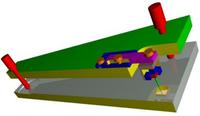 A group at University of Münster in Germany are giving away the complete DIY plans for building your own Scanning Tunneling Microscope. That would be a key piece if you plan on experimenting with nanotech in your garage. The interesting part is that this is open source technology. Here's part of their license: A group at University of Münster in Germany are giving away the complete DIY plans for building your own Scanning Tunneling Microscope. That would be a key piece if you plan on experimenting with nanotech in your garage. The interesting part is that this is open source technology. Here's part of their license:We grant everybody the right to construct the microscope using the here-published design for private or educational purposes. On these web pages all necessary diagrams, drawings, material descriptions and software-source-codes are published for free access. While granting the right to build the microscope we make it mandatory that new developments, improvements or other applications of our design are also made openly available for private or educational purposes.
[ Technology | 2004-01-04 11:05 | | PermaLink ] More >
|
|
| Wednesday, December 10, 2003 |  |
|
|
|
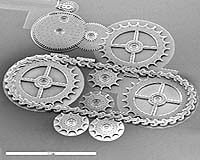 It is not just software that can be open source. Slashdot writes about an open source chip design. Well, it is still related to software, but it is a step further. It is not just software that can be open source. Slashdot writes about an open source chip design. Well, it is still related to software, but it is a step further.
Imagine for a moment the not-too-distant future when cheap nanotech matter compilers are available that can build stuff from basic atoms. It then becomes all-important to have easy access to good design blueprints for the stuff we need and want.
I would guess that for people who build complicated physical things today, like cars, there are a lot of intellectual property issues involved. The patents for the fuel injectors and the airbags and the transmission, and so forth, for hundreds of different pieces - they probably are owned by different companies, and complicated contracts and license agreements need to be worked out. Which is not such a big deal when we're talking about centralized production and billion dollar production plants and companies with 10s of thousands of people. But if I had the actual capability to build the car out of atoms directly in my garage, those issues would kill the whole thing.
So, we need high quality open source plans for building *everything*.
[ Technology | 2003-12-10 14:22 | | PermaLink ] More >
|
|
| Tuesday, November 25, 2003 |  |
|
|
|
 Via Smart Mobs, news about Urban Tapestries, which is an experimental project for understanding the social and cultural implications of location-based mobile communications. They have developed a mechanism by which individuals can virtually annotate the urban landscape with personal stories and commentary. Via Smart Mobs, news about Urban Tapestries, which is an experimental project for understanding the social and cultural implications of location-based mobile communications. They have developed a mechanism by which individuals can virtually annotate the urban landscape with personal stories and commentary.Imagine building your own location-based game, such as a treasure hunt or a spy game.
Imagine creating a thread of local resources that would be useful or important to you if you lived in this area. For instance specialist food shops, bookstores, places to learn new things, exercise classes, social services, free concerts and films, public toilets and local dumps.
Imagine creating your own story woven through the area. For instance a romance or crime story, science fiction or horror (English country pursuits)!
Imagine annotating places for local activist campaigns or issues. For instance local pollution and the environment, building developments and regeneration, globalisation and local transport.
Imagine creating your own personal map of Bloomsbury. For instance quiet places to sit, favourite parks, family histories, unhappy memories and bad smells! They are launching a public trial in London in December.
[ Technology | 2003-11-25 10:11 | 0 comments | PermaLink ]
|
|
| Monday, November 24, 2003 |  |
|
|
|
 My friend from L.A. Roger Eaton is on a quest. Nothing less than the software that would enable the voice of humanity to be articulated. The wiring that might allow us to pool our thoughts and have our collective mind express what we think and feel and what we want to do. So we can then better take action and set our world straight. Not exactly an easy project, but somebody needs to do it. My friend from L.A. Roger Eaton is on a quest. Nothing less than the software that would enable the voice of humanity to be articulated. The wiring that might allow us to pool our thoughts and have our collective mind express what we think and feel and what we want to do. So we can then better take action and set our world straight. Not exactly an easy project, but somebody needs to do it.
Luckily there are many other individuals and groups and projects and tools that fit in with that, and which one way another works towards it. Nobody can do it alone. Roger is now methodically going through what is out there that might relate, and providing good overviews and analysis of what he finds. Read about it in his blog
[ Technology | 2003-11-24 05:55 | | PermaLink ] More >
|
|
|
|
Chandler is an open source project envisioned and spearheaded by Mitch Kapor. A very ambitious and well-funded effort, working on bunch of things that really need doing. At the very first glance it might seem like nothing special, just another e-mail, calendar, to-do list kind of program. But it the way it aims and doing things, and how shared it will be that is interesting. See Roger's overview of places to learn more. Like this Compelling Vision.With Chandler, users will be able to organize diverse kinds of information for their own convenience -- not the computer's convenience. Chandler will have a rich ability not only to associate and interconnect items, but also to gather and collect related items in a single place creating a context sensitive "view" of many types of data, mixing-and-matching email, mailing lists, instant messages, appointments, contacts, tasks, free-form notes, blogs, web pages, documents, spreadsheets, slide shows, bookmarks, photos, MP3's, and so on (and on). Data in Chandler is stored on repositories on the user's local machine, on others' machines, and on shared resources such as servers.
This is a very different approach from that of today's common PIMs. For example, users can usually only view a given email message in one specific folder, grouped only with other email messages. In the user-centric world of Chandler, the basis of the ‘relatedness’ of items is completely at the users discretion and is merely facilitated, rather than imposed by the software.
Chandler lets the user keep track of lots of concurrent, ongoing activities. Managing activity extending over time requires the ability to collect just the right sets of related items. Too much information and the user the can't find what's relevant. Too little information and the needed item goes missing. This ability to gather relevant information from disparate sources is at the heart of Chandler's design. A Chandler user could, for example, relate a variety of emails, contacts, documents, and calendar events into an ad-hoc collection related to a specific project.
Chandler will provide unified search over all of the user's information, both on her own personal computer(s) and stored in other Chandler repositories across the network. It will allow searches to be saved for re-use.
Chandler will give non-programming users the ability to customize and extend the program in all sorts of ways, for instance, providing ways to automatically manage complex, asynchronous tasks like organizing a meeting and to automatically respond to events as they arise. I've known for a long time that this is what I would want. Seems obvious. And I've made a few attempts of programming pieces of that, that I've never finished. Nobody else seems to be doing it right. But I bet Chandler will go where it intends to go.
[ Technology | 2003-11-24 05:37 | 0 comments | PermaLink ]
|
|
| Tuesday, October 21, 2003 |  |
|
|
|
 From Ananova via SmartMobs: From Ananova via SmartMobs:A window between cities that allows people hundreds or even thousands of miles apart to meet and talk could make its debut in Britain next year.
Tholos, named after a type of circular ancient Greek temple, consists of a large round screen nearly 10ft high and 23ft wide.
Its designers hope to see one of the first two in the world become a new tourist attraction in the centre of London.
The London Tholos would be linked to an identical one in Vienna. Through them, people in both cities will be able to see and hear each other in real time.
The cylindrical structure contains technology that simultaneously transmits and receives high definition live moving images.
People standing in front of London's Tholos would see a wrap-around picture of the scene in Vienna. At the same time, a similar London image is displayed in the Austrian capital.
Citizens in both countries would be able to face each other and talk via an array of directional microphones and loudspeakers, which keep conversations private.
Effectively, it is like meeting up in the town square - except that you might be on different continents. Very, very cool. Let's get one in Baghdad and Tel Aviv and Addis Ababa and every city in the world. Only annoying part is that it is financed by advertising. So, 13% of the time you'll apparently have your conversation interrupted by ads. But I guess one could get used to that.
[ Technology | 2003-10-21 09:54 | | PermaLink ] More >
|
|
| Monday, June 16, 2003 |  |
|
|
|
 I'm green with envy about not having a cell phone with built-in camera. Xeni Jardin has a nice article in Wired about the phonecam phenomenon. I'm green with envy about not having a cell phone with built-in camera. Xeni Jardin has a nice article in Wired about the phonecam phenomenon.The trend started innocuously a few years ago, when novelty cameras that plugged into mobile handsets were marketed to gadget-obsessed kids in Japan and Europe. But in the past few months, a global phonecam revolution has begun to emerge. Take the device's portability, add its ability to post images online, multiply by its growing ubiquity, and what do you get? A cheap, fast strain of DIY publishing in which everyone is an embedded reporter. The rise of the technology resembles the leap from late-'90s personal homepages to today's weblogs: Like blogs, phonecams are a fresh combination of familiar elements that equal way more than the sum of their parts. A "moblog" is then when people post pictures they take with their phonecams on weblogs. Which provides a more lively way of connecting with what people are doing and what they experience during the day. I always have a digital camera in my pocket, but still, since I have to go through several steps, of taking it home and downloading it, and uploading a picture, it isn't really something I use to document my day. But with a phonecam it would be more of a one-step process and would flow more easily. So, I'm hoping that a Nokia 3650 will fit in my budget sometime soon. Like, when I get new cell accounts in France. The deals don't look as great there yet as in some other places, but hopefully they'll get better.
[ Technology | 2003-06-16 22:49 | 0 comments | PermaLink ]
|
|
| Friday, June 13, 2003 |  |
|
|
|
At this evening's L.A. Futurist meeting the speaker was Mike Korns. He runs a company that develops artificial intelligence applications, particularly for automatic stock market investing. What is interesting is that we're talking about programs that more or less developed themselves, according to evolutionary computing models. Borrowing approaches from genetics. Natural selection, mutations and even sexual exchange of genomes. Basically, what nature does works very well, and has been found to work very well, also when modelled by computer programs. In this case, many gigabytes of program agents have been evolved, which demonstrate remarkable results in what they do. The Deep Green automated investment system has had an average of 23% gains per year over the past 10 years, which is better than any mutual fund out there.
[ Technology | 2003-06-13 23:59 | | PermaLink ] More >
|
|
| Wednesday, June 4, 2003 |  |
|
|
|
Scientific American has an article about self-repairing computers. Sounded promising, but instead it illustrates how we're in dire need of a paradigm change in computer design. The thinking of the researches mentioned in the article is that reboots usually fix things, but it takes too long, so we need micro-reboots, where smaller portions of the system can be rebooted by themselves. Well, sure, that's maybe a good thing, but if that's the best we can look forward to in terms of fault-tolerant computers, that is incredibly lame. Then Microsoft can come up with a micro-reinstall that will reinstall parts of your system several times each second.
What would be more interesting would be to rethink the way we do most of our technology. Most devices we use have single points of failure, and we've somehow ended up designing our software in a similar fashion. Your computer is full of tiny little copper wires, and a great many of them would cause the computer to stop functioning if you cut even one of them. The answer, if you send it to repair, would be that you'll buy a new motherboard. Even if you don't break anything, but you just cut power for 1/10 second, your computer will go down. And as far as the software goes, a misplaced comma, or a zero that should be a one, that's often enough for bringing down the whole thing. It just seems so primitive.
Compare with organic life forms. Look at anything that is alive and you'll find that it is self-repairing and extremely fault-tolerant. Most animals will keep going even with missing limbs, wounded, being fed crap, and in unfamiliar circumstances. The only thing that will bring an oganism down is some kind of systemic failure. Not just losing a few million cells, but a bunch of big things at the same time that will sabotage how the whole thing coordinates its activities.
Why can't I have technology like that? Why can't I use programs like that? Stuff that keeps working, even with heavy damage. Well, as a programmer I can of course start answering that. We don't know how to do that. We know how to do it on a small scale. We can make servers that have multiple hot-swappable power supplies. We can with some effort set up mirrored servers that will take over for each other. We can set up battery backed power supplies that take over when the power goes. And in software we can divide the functionality into "objects" that each will check and double-check everything, and try to recover from problems. But it isn't any pervasive philosophy, and it is built on a fragile foundation. If we are concerned about something needing to always be up, we might put in two or three or a certain component. But even when that mostly works, it is a very feeble attempt of fault-tolerance. Nature's way seems to be to have thousands or millions of independent but cooperating units, each having a knowledge of what needs to be done, but each going about it slightly differently.
Translated to the software world, does that mean we ought to write all programs as a large number of independnet agents or objects or even viruses, that somehow work together in getting things done? Or would neural networks do the trick? I wish I knew.
[ Technology | 2003-06-04 18:43 | | PermaLink ] More >
|
|
| Wednesday, May 14, 2003 |  |
|
|
|
There's a buzz about social software, software for better connecting people together, facilitating that they find like-minded people, work more closely together, etc. Ray Ozzie, the creator of Lotus Notes and now Groove, says:"What's incredibly exciting to me is that a confluence of factors e.g. ubiquitous computing, networking, web and RAD technologies, the state of the job market - in essence, loosely coupled systems and loosely coupled minds - have created what amounts to a petri dish for experimentation in systems for social network formation, management and interpersonal interaction. An exciting time to be exploring what may happen to social structures, to organizations and to society when the friction between our minds can be reduced to zero ... to the point where we can truly have superconductive relationships." Superconductive Relationships! Yeah, that's what I'm looking for. But, if you follow the link to Don Park's Blog to "Misgivings about Social Software", you'll see that there are also potentially negative sides to examine."Korea is emerging as one of the most advanced Internet nation in the world. Young Koreans, in particular, live and breath Internet, each belonging to large number of online communities. One would expect them to be well informed and objective, yet they are not. Their views are warped and often radical. While all the world's information is at their fingertip, they consume information subjectively and produce misinformation biased by their views. Adding highly effective social software to this is frightening to me.
When I was last in Korea, a close friend of mine told me he was thinking about sending his six-year old daughter to schools in the US. I was shocked. How could he think this way? He said he initially thought the idea ridiculous, but he changed his mind after talking with people he knew, people who are just as well-to-do as his family. Apparently, they are all thinking the same thing and this warped his common sense." There's a point there. Sufficiently pervasive and effective social software might allow groups of people to walk around in a completely different reality, and have it be continuously reinforced by people you're connected with. I suppose we're for example talking about players of online multi-player virtual reality games. And I do notice that for my 16 year old son, his social relationships within Asheron's Call, or whatever he's playing right now, often are more real than then ones in this world. And if we make the software better and better? Hmmm.
[ Technology | 2003-05-14 15:01 | | PermaLink ] More >
|
|
| Monday, May 12, 2003 |  |
|
|
|
Via FuturePositive, Ray Kurzweil being interviewed on the accelerating rate of change.The Law of Accelerating Returns is the acceleration of technology, and the evolutionary growth of the products of an evolutionary process. And this really goes back to the roots of biological evolution.
Evolution works through indirection. You create something and then work through that to create the next stage. And for that reason, the next stage is more powerful, and happens more quickly. And that has been accelerating ever since the dawn of evolution on this planet.
The first stage of evolution took billions of years. DNA was being created and that was very significant because it was like a little computer, and an information processing method to store the results of experiments, and to build up a knowledge base from which it could then launch experiments and codify the results.
The subsequent stages of evolution happened much more quickly. The Cambrian Explosion only took a few tens of millions of years to establish the body plan to evolve animals. And we see that evolution, like certain technologies, has become mature and stopped evolving. Evolution has concentrated on other issues, specifically higher cortical functions. And that happened much more quickly than the Cambrian Explosion. Humanoids evolved over many millions of years, and Homo sapiens over only hundreds of thousands of years. And there again, evolution used the products of its evolutionary processes, which was Homo sapiens, to create the next stage, which was human-directed technology, which really is a continuation of the cutting-edge of the evolutionary process on earth, for creating more intelligent systems.
In the first stage of human-directed technology, it took tens of thousands of years, which is what you would expect for the next stage via the wheel, or stone tools, and that kept accelerating, because when we had stone tools, we could use them to build the next stage. So a thousand years ago a paradigm shift only took a century, like the printing press. And now a paradigm shift, like the World Wide Web, is measured in only a few years’ time. The first computers were built with screwdrivers and were designed with pencil and paper, and today we use computers to create computers. A CAD designer will sit down and specify a few high-level parameters, and 12 different layers of automated designs will be done automatically. The most significant acceleration is in the paradigm shift rate itself, which I think of as the rate of technical progress. And all of these are actually not exponential, but double exponentials because not only does the process accelerate because of our evolution’s ability to use each stage of evolution to build the next stage, but also, as the process, as an area gets higher price performance, more resources get drawn into that capability.[..]
The whole 20th century, because we’ve been speeding up to this point, is equivalent to 20 years of progress at today’s rate of progress, and we’ll make another 20 years of progress at today’s rate of progress equal to the whole 20th century in the next 14 years, and then we’ll do it again in seven years. And because of the explosive power of exponential growth, the 21st century will be equivalent to 20,000 years of progress at today’s rate of progress, which is a thousand times greater than the 20th century, which was no slouch to change. Kurzweil is one of the proponents of The Singularity - the idea that a number of accelerating technological trends are going to converge in a way that will totally transform our existence. In our lifetimes. Nanotechnology, Artificial Intelligence, Genetic Engineering, and more. Personally, I agree that there's something like that going on, and that life as we know it will totally change, but I don't see it quite as materialistically. I think WE are evolving and transforming WITH and THROUGH technology. Which is a very risky thing to do so quickly. But I don't quite go along with the idea that one of our main concerns will be that robots will become smarter than us.
[ Technology | 2003-05-12 18:08 | | PermaLink ] More >
|
|
|
|
 Headmap posts a manifesto of sorts. Well, maybe more of an overview of what is cooking on the net than a manifesto, but great stuff. Headmap posts a manifesto of sorts. Well, maybe more of an overview of what is cooking on the net than a manifesto, but great stuff.The last six months have seen a new embryonic internet emerge into the light.
This new internet is more decentralised, structured, logically interconnected, people centred, and increasingly location aware
..maybe you have a newsreader that goes and gets rss feeds to save you trawling your favourite sites, maybe you have a blog which kicks out a structured rss feed and pings a blog search and analysis engine. Maybe you use one of the new selective blog search engines like feedster or blog link analysis engines like blogdex and technorati, or even a blog extended family tracker like blogstreet. Maybe you see the patterns emerging at a higher level. Blogs are now less interesting than the relations between them. Blogs are things to be aggregated, searched for patterns, ranked, indexed, analysed, those results being valuable to ordinary users as much as academics. What are bloggers tripping out on right now? Check blogdex. Feedster has a lag of about an hour, Google sometimes as much as a month. These tools are selective and they can become more so, answer questions like: what is this extended familly of bloggers tripping out about, what are my friends tripping out about?
All these new capabilities are emerging through distributed collectve tweaking. Distributed collective tweaking, yes that's a good way of putting it. Maybe the whole world can change based simply on distributed collective tweaking. Lots of smart people making one thing or the other work a bit better, connecting their pieces together.
[ Technology | 2003-05-12 16:50 | | PermaLink ] More >
|
|
| Saturday, May 10, 2003 |  |
|
|
|
SmartMobs:This article from SPACE.com about the Interplanetary Internet (IPN) is not science fiction. Rich Gray reports it is becoming a reality.The IPN would form a backbone connecting a series of hubs on or around planets, ships, and at other points in space. These hubs would provide high-capacity, high-availability Internet traffic over distances that could stretch up to hundreds of millions of miles. Gray adds that all the planets and satellites in our solar system have already Internet addresses and that NASA is already communicating with its earth-orbiting missions through its internal Deep Space Network. The rest of us will have to wait until at least 2005 when IPN-equipped satellites are launched
Check this column for more details. I can't wait to get an ICQ message from Mars. Not that I know anybody on Mars.
[ Technology | 2003-05-10 22:07 | 0 comments | PermaLink ]
|
|
|
|
Recently I've accepted invites to LinkedIn, Ryze, Friendster and probably other networking sites I'm forgetting. Stuart Henshall has some excellent commentary on experiences with these. And it also reminds me, of course, that I have my own contact networking site, NCN, and I went and looked at my own contact list. And, regardless of what kind of nice features it is surrounded with, I must admit that it suffers from some of the same problems that any of these schemes will suffer from. All of them require that one signs up into a central database, and fills in one's profile from scratch, and then one has some way of adding new contacts to one's network. Unfortunately that only works really well if the networks happens to be so super popular that *everybody* is using it.
When I look at my own NCN contact list of 216 people, it has some nice features, quite competitive with the other guys. But most of the people on the list haven't logged into the network for a long time, so their information isn't particularly up-to-date. 3 of them are dead. It is not a big wonder. The network has existed for 8 years, and of course the close to 8000 people who have signed up are not going to sign in every day, unless there is something mind-blowing going on that doesn't happen anywhere else. So, at any given time, maybe a hundred people or two are paying attention on a very regular basis.
What would change it would either be if most of that kind of networking sites and directories of people would work together and share and aggregate information, OR, if one's public persona isn't stored on multiple island databases, but on one's own computer. I can't really go around remembering all the places I've signed up. Really makes the most sense if I maintain my own version of who I am on my own machine, or at least in one particular place I've chosen to be authoritative.
But what about all the relationship info? What other people have to say about me. What level of data-sharing friendlyness they choose to extend to me. It shouldn't be too hard to work out a scheme where this might be stored redundantly both with my data and with theirs. I make a comment about you, it gets stored in my file for you, pointing to your site for the details of who you are. My machine would also ping your machine and let it know that I said something in relation to you, and your machine would have the opportunity of grabbing a copy of it.
Is FOAF - Friend of a Friend - something that is suitable for this? I don't really understand it well enough yet.
[ Technology | 2003-05-10 21:39 | | PermaLink ] More >
|
|
<< Newer stories Page: 1 2 3 4 5 6 Older stories >> |

